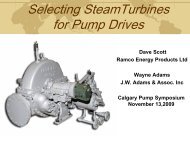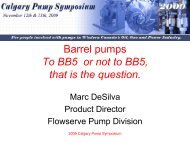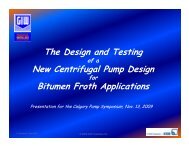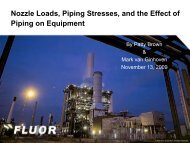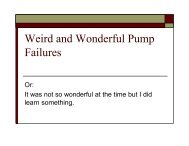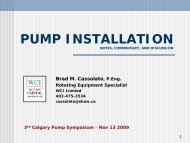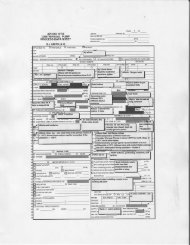Download PDF - Calgary Pump Symposium
Download PDF - Calgary Pump Symposium
Download PDF - Calgary Pump Symposium
Create successful ePaper yourself
Turn your PDF publications into a flip-book with our unique Google optimized e-Paper software.
Weir Minerals North America<br />
Presentation to:<br />
<strong>Calgary</strong> <strong>Pump</strong> <strong>Symposium</strong><br />
November 2009<br />
Prepared by:<br />
Michael Bootle<br />
Senior Design Engineer<br />
Excellent<br />
Minerals<br />
Solutions<br />
Wear in Rotodynamic<br />
(Centrifugal)<br />
Slurry <strong>Pump</strong>s
Weir Minerals North America<br />
Excellent<br />
Minerals<br />
Solutions<br />
Modes of Wear in Slurry <strong>Pump</strong>s<br />
•Abrasion<br />
•Corrosion<br />
•Erosion<br />
2
Weir Minerals North America<br />
Excellent<br />
Minerals<br />
Solutions<br />
Wear Locations<br />
• Fully Lined <strong>Pump</strong><br />
3
Weir Minerals North America<br />
Excellent<br />
Minerals<br />
Solutions<br />
Wear Locations<br />
• Unlined <strong>Pump</strong><br />
4
Weir Minerals North America<br />
Excellent<br />
Minerals<br />
Solutions<br />
Abrasion
Weir Minerals North America<br />
Excellent<br />
Minerals<br />
Solutions<br />
Abrasion<br />
• Forcing of hard particles against a wear surface<br />
6
Weir Minerals North America<br />
Excellent<br />
Minerals<br />
Solutions<br />
Abrasion<br />
• Locations within a<br />
slurry pump:<br />
• between shaft<br />
sleeve and packing<br />
• between impeller<br />
and suction side<br />
liner at tight<br />
clearance area<br />
adjacent to impeller<br />
wear ring/dam near<br />
impeller eye<br />
7
Weir Minerals North America<br />
Excellent<br />
Minerals<br />
Solutions<br />
Abrasion<br />
• Worn Sleeve: Hourglass wear within 12 hours of seal water failure<br />
8
Weir Minerals North America<br />
Excellent<br />
Minerals<br />
Solutions<br />
Corrosion
Weir Minerals North America<br />
Excellent<br />
Minerals<br />
Solutions<br />
Corrosion<br />
• Abrasion resistant white irons used in slurry<br />
pumps consist of hard carbides in a ferrous<br />
matrix.<br />
• The M 7 C 3 carbides are electrochemically<br />
passive and essentially protected from<br />
corrosion.<br />
• The corrosion resistance of the material is<br />
therefore a function of the corrosion resistance<br />
of matrix, which in turn is a function of the<br />
chromium content with in the matrix.<br />
• Corrosion of the supporting ferrous matrix can<br />
lead to premature fracture and spalling of the<br />
carbides.<br />
Chromium carbides in<br />
supporting ferrous matrix<br />
10
Weir Minerals North America<br />
Excellent<br />
Minerals<br />
Solutions<br />
Corrosion<br />
• Inter-phase corrosion can occur at the interface between the M 7 C 3<br />
carbides and the ferrous matrix resulting in intergranular corrosion:<br />
11
Weir Minerals North America<br />
Excellent<br />
Minerals<br />
Solutions<br />
Corrosion<br />
• Corrosion pitting from<br />
low pH flue gas<br />
entering a scrubber<br />
pump during shut-down<br />
12
Weir Minerals North America<br />
Excellent<br />
Minerals<br />
Solutions<br />
Corrosion<br />
• Above water line<br />
corrosion on 27%<br />
high chrome iron<br />
material<br />
13
Weir Minerals North America<br />
Excellent<br />
Minerals<br />
Solutions<br />
Corrosion<br />
• Depth of Corrosion<br />
Pitting can be substantial<br />
14
Weir Minerals North America<br />
Excellent<br />
Minerals<br />
Solutions<br />
Corrosion<br />
• 30% Potash Tailings in<br />
brine solution<br />
• Corrosion on<br />
unsubmerged portion<br />
of high chrome impeller<br />
• Severe imbalance due<br />
to uneven weight loss<br />
15
Weir Minerals North America<br />
Excellent<br />
Minerals<br />
Solutions<br />
Corrosion/Erosion<br />
• 8 inch Froth <strong>Pump</strong>:<br />
Cyclone Feed Service<br />
in concentrate flotation<br />
regrind circuit at a<br />
Nickel Mine<br />
• Large inlet<br />
• Progressive reduction in<br />
corrosion from aerated<br />
inlet to pump discharge<br />
16
Weir Minerals North America<br />
Excellent<br />
Minerals<br />
Solutions<br />
Corrosion/Erosion<br />
• 8 inch Froth <strong>Pump</strong> on Cyclone<br />
Feed service in concentrate<br />
flotation regrind circuit at a Nickel<br />
Mine<br />
• Severe corrosion to throatbush<br />
on aerated inlet side of the pump<br />
17
Weir Minerals North America<br />
Excellent<br />
Minerals<br />
Solutions<br />
Corrosion/Erosion<br />
• 8 inch Froth <strong>Pump</strong> at Nickel Mine:<br />
• Less corrosion on impeller<br />
18
Weir Minerals North America<br />
Excellent<br />
Minerals<br />
Solutions<br />
Corrosion/Erosion<br />
• 8 inch Froth <strong>Pump</strong> at Nickel Mine:<br />
• Slightly less corrosion on volute and frameplate liner insert<br />
19
Weir Minerals North America<br />
Excellent<br />
Minerals<br />
Solutions<br />
Corrosion/Erosion<br />
• 10/8 AH on Heavy Media<br />
circuit in Potash Mine:<br />
• Magnetite, potash,<br />
brine solution<br />
• “Dry running” centrifugal<br />
shaft seal<br />
• Progressive reduction in<br />
corrosion from aerated<br />
seal area to pump<br />
discharge<br />
20
Weir Minerals North America<br />
Excellent<br />
Minerals<br />
Solutions<br />
Corrosion/Erosion<br />
• 10/8 AH on Heavy Media<br />
circuit in Potash Mine:<br />
• Magnetite, potash, brine<br />
solution<br />
• Expeller ring/stuffing box<br />
• Note slurry/air interface<br />
21
Weir Minerals North America<br />
Excellent<br />
Minerals<br />
Solutions<br />
Corrosion/Erosion<br />
• 10/8 AH Expeller on Heavy Media circuit in Potash Mine:<br />
• Magnetite, potash, brine solution<br />
22
Weir Minerals North America<br />
Excellent<br />
Minerals<br />
Solutions<br />
Corrosion/Erosion<br />
• 10/8 AH Back Liner on Heavy Media circuit in Potash Mine:<br />
• Magnetite, potash, brine solution<br />
• Note demarcation line of level of wear just outboard of Back Liner ID.<br />
23
Weir Minerals North America<br />
Excellent<br />
Minerals<br />
Solutions<br />
Corrosion/Erosion<br />
• 10/8 AH Impeller and Volute on Heavy Media circuit in Potash Mine:<br />
• Magnetite, potash, brine solution<br />
• Note further reductions in level of corrosion on Impeller and Volute.<br />
24
Weir Minerals North America<br />
Excellent<br />
Minerals<br />
Solutions<br />
Corrosion/Erosion<br />
• Corrosion/Erosion with Erosion being a large contributing factor:<br />
25
Weir Minerals North America<br />
Excellent<br />
Minerals<br />
Solutions<br />
Erosion
Weir Minerals North America<br />
Excellent<br />
Minerals<br />
Solutions<br />
Erosion<br />
• Three primary modes of erosion:<br />
• Deformation wear: Direct impact to the leading edge of the impeller vanes,<br />
the back shroud of the impeller and the “protruding” cutwater of the volute.<br />
• Random impingement: Random impacts to the impeller shroud and trailing<br />
edge of the main pumping vanes<br />
• Low angle impact: Wear from the tangential or near tangential movement of<br />
particles against the volute casing or vane surface<br />
27
Weir Minerals North America<br />
Excellent<br />
Minerals<br />
Solutions<br />
Erosion<br />
• Factors affecting erosion:<br />
• Contact conditions<br />
• Kinetic energy of particle:<br />
Particle mass (specific gravity) and<br />
velocity<br />
• Particle size<br />
• Particle shape:<br />
Sharp particles have small contact<br />
area and high local stress<br />
• Particle hardness<br />
• Slurry concentration:<br />
A higher percentage of solids<br />
results in more impacts for a given<br />
flow<br />
• Material properties<br />
28
Weir Minerals North America<br />
Excellent<br />
Minerals<br />
Solutions<br />
Erosion<br />
• Fine particle slurries eat away at the softer matrix leaving the hard<br />
carbides vulnerable to spalling and flaking off.<br />
29
Weir Minerals North America<br />
Excellent<br />
Minerals<br />
Solutions<br />
Erosion<br />
• Fine particles tend to follow fluid flow streamlines<br />
• Large particles tend to travel straight<br />
30
Weir Minerals North America<br />
Excellent<br />
Minerals<br />
Solutions<br />
Erosion<br />
• Effect of Particle Size on Wear:<br />
D85 = 650 micron particle<br />
D85 = 6000 micron particle<br />
31
Weir Minerals North America<br />
Excellent<br />
Minerals<br />
Solutions<br />
Erosion<br />
• Large particle wear to back<br />
side of impeller<br />
• Copper mine ball mill<br />
discharge<br />
• 400+ micron d50 particle<br />
size<br />
• Operation near best<br />
efficiency flow<br />
• 1848 hours<br />
32
Weir Minerals North America<br />
Excellent<br />
Minerals<br />
Solutions<br />
Erosion<br />
• Large particle wear to back side of impeller: copper ball mill discharge<br />
33
Weir Minerals North America<br />
Excellent<br />
Minerals<br />
Solutions<br />
Erosion<br />
• Zinc Tailings application:<br />
• 55 to 65% C w<br />
• 3.79 sg of dry solids<br />
• 25 micron d50<br />
• 11 to 12 pH<br />
• 3/2 DHH High Head <strong>Pump</strong>:<br />
• 70 m3/hr @ 44.8 to 75.6 m<br />
• 1052 to 1350 rpm<br />
• 54 to 69% of BEP<br />
• Fine particle “eddy current”<br />
wear<br />
• Minimal wear to leading<br />
edge of main pumping vanes<br />
34
Weir Minerals North America<br />
Excellent<br />
Minerals<br />
Solutions<br />
Erosion<br />
• Fine Particle Zinc<br />
Tailings Application<br />
• 54 to 69% of best<br />
efficiency flow<br />
• Low flow suction liner<br />
wear<br />
• Fine particles follow<br />
eddy currents<br />
• Vortex/Rat Holing type<br />
wear<br />
35
Weir Minerals North America<br />
Excellent<br />
Minerals<br />
Solutions<br />
Erosion<br />
• Fine Particle Zinc Tailings<br />
Application<br />
• 54 to 69% of best efficiency<br />
flow<br />
• Low flow volute liner wear<br />
• Eddy current wear beyond<br />
“cutwater”<br />
• Leading edge of cutwater in<br />
reasonably good shape<br />
36
Weir Minerals North America<br />
Excellent<br />
Minerals<br />
Solutions<br />
Erosion<br />
• Effect of Operation Below BEP:<br />
(throatbush)<br />
37
Weir Minerals North America<br />
Excellent<br />
Minerals<br />
Solutions<br />
Erosion<br />
• Wear on Casing Liner and Throatbush as a Result of Low Flow:<br />
38
Weir Minerals North America<br />
Excellent<br />
Minerals<br />
Solutions<br />
Erosion<br />
• Copper Mine Ball Mill Discharge Cyclone<br />
Feed <strong>Pump</strong><br />
• High Efficiency Volute Design:<br />
• True volute<br />
• Tight impeller to cutwater clearance<br />
• Severe low flow large particle wear<br />
beyond cutwater<br />
• d50 = 250 microns<br />
39
Weir Minerals North America<br />
Excellent<br />
Minerals<br />
Solutions<br />
Erosion<br />
• Copper Mine Ball Mill<br />
Discharge Cyclone Feed<br />
<strong>Pump</strong><br />
• Severe erosion at wear<br />
dam area adjacent to<br />
impeller eye<br />
• d50 = 250 microns<br />
40
Weir Minerals North America<br />
Excellent<br />
Minerals<br />
Solutions<br />
Solutions
Weir Minerals North America<br />
Excellent<br />
Minerals<br />
Solutions<br />
Solutions<br />
•Materials<br />
•Geometry<br />
•Application/Process<br />
42
Weir Minerals North America<br />
Excellent<br />
Minerals<br />
Solutions<br />
Materials: Duplex Stainless Steels<br />
• Duplex stainless steels:<br />
• CD4MCu<br />
• Ferrallium 255<br />
• Two phase structure of ferritic and austenitic stainless steel<br />
• Good resistance to stress corrosion cracking<br />
• Nominal hardness of 250 HBN better than austenitic stainless steels<br />
but far poorer than high chrome irons (400 - 800 BHN)<br />
• Therefore, relatively poor erosion resistance for slurry service<br />
43
Weir Minerals North America<br />
Excellent<br />
Minerals<br />
Solutions<br />
Materials: White Cast Irons<br />
• Consist of hard carbides within a supporting ferrous matrix<br />
• Carbide types:<br />
• Iron Carbide:<br />
• Chromium Carbide (M 7<br />
C 3<br />
):<br />
• Matrix types:<br />
• Ferrite:<br />
• Austenite:<br />
• Martensite:<br />
850 to 1000 HV<br />
1200 to 1500 HV<br />
150 to 250 HV<br />
300 to 500 HV<br />
500 to 1000 HV<br />
• Bulk hardness dependent upon carbide and matrix type and the<br />
volume of carbides in the matrix<br />
• Typical hardness of silica sand:<br />
1200 HV<br />
44
Weir Minerals North America<br />
Excellent<br />
Minerals<br />
Solutions<br />
Materials: White Cast Irons<br />
• Medium to large particle applications:<br />
• Bulk hardness important<br />
• Small particle applications:<br />
• Fine carbide microstructure with smaller inter-carbide spacing important<br />
to minimize erosion of the softer matrix<br />
• Very large particle applications:<br />
• Fracture toughness of the matrix most important<br />
• Corrosive applications:<br />
• Corrosion resistance of the matrix most important<br />
45
Weir Minerals North America<br />
Excellent<br />
Minerals<br />
Solutions<br />
Materials: White Cast Irons (Conventional)<br />
40<br />
Chemistry of White Cast Irons<br />
Chromium<br />
30<br />
20<br />
10<br />
ISO 21988 AS 2027<br />
HBW555XCr26<br />
HBW555XCr21<br />
HBW555XCr16<br />
HBW555<br />
27Cr<br />
20Cr-2Mo<br />
15Cr-3Mo<br />
Ni-hard 4<br />
ASTM A532<br />
Class IIIA<br />
Class II D<br />
Class II B<br />
Class I D<br />
HBW510<br />
Ni-Hard 1<br />
Class I A<br />
2 3 4 5<br />
Carbon<br />
46
Weir Minerals North America<br />
Excellent<br />
Minerals<br />
Solutions<br />
Materials: White Cast Irons (Conventional)<br />
• Approximately the same carbon content:<br />
• 3% carbon<br />
• Therefore, similar microstructure for Class II & III :<br />
• 20 to 25 volume % of hard chromium carbides in a<br />
ferrous matrix.<br />
• 27% Cr developed and patented in 1917. Cr-Mo<br />
& Ni-Hard quickly followed.<br />
47
Weir Minerals North America<br />
Excellent<br />
Minerals<br />
Solutions<br />
Materials: White Cast Irons (Conventional)<br />
Microanalysis of White Cast Irons<br />
Cr27<br />
Fe-27Cr-3.0C<br />
Phase Vol% Cr C<br />
• Carbide 25 55 8.8<br />
• Matrix 75 18 1.1<br />
• Total 100 27 3.0<br />
(Fe,Cr) 7 C 3<br />
27%Cr is essentially an 18%Cr - 1.1%C tool steel<br />
containing 25 volume% chromium carbides<br />
48
Weir Minerals North America<br />
Excellent<br />
Minerals<br />
Solutions<br />
Materials: White Cast Irons (Conventional)<br />
Microanalysis of White Cast Irons<br />
15Cr-3Mo<br />
Fe-15Cr-3.0C<br />
Phase Vol% Cr C<br />
• Carbide 20 47 8.7<br />
• Matrix 80 7.0 1.6<br />
• Total 100 15.0 3.0<br />
(Fe,Cr) 7 C 3<br />
15Cr-3Mo is essentially a 7%Cr - 1.6%C tool steel<br />
containing 20 volume% chromium carbides<br />
49
Weir Minerals North America<br />
Excellent<br />
Minerals<br />
Solutions<br />
Materials: 27% Cr versus 15 Cr–3 Mo<br />
• Comparison of 27% Cr & 15% Cr–3% Mo<br />
Worn Impellers at Mexican Copper Mine<br />
50
Weir Minerals North America<br />
Excellent<br />
Minerals<br />
Solutions<br />
Materials: Hyperchrome Chemistry<br />
Chromium<br />
40<br />
30<br />
20<br />
10<br />
ISO designation<br />
HBW600XCr35<br />
HBW555XCr26<br />
HBW555XCr21<br />
HBW555XCr16<br />
HBW555<br />
27Cr<br />
35C<br />
Hyperchrome<br />
r<br />
20Cr-2Mo<br />
15Cr-3Mo<br />
Nihard 4<br />
35Cr<br />
AS designation<br />
HBW510<br />
Nihard 1<br />
2 3 4 5<br />
Carbon<br />
51
Weir Minerals North America<br />
Excellent<br />
Minerals<br />
Solutions<br />
Materials: Hyperchrome<br />
Microanalysis of WCI-4.5%C<br />
Fe-31Cr-4.5C<br />
Phase Vol% Cr C<br />
• Carbide 48 52 8.7<br />
• Matrix 52 12 0.6<br />
• Total 100 31 4.5<br />
(Fe,Cr) 7 C 3<br />
WCI-4.5%C has a Hypereutectic microstructure<br />
with a high M 7 C 3 carbide content and a ferrous<br />
matrix containing 12 wt% chromium.<br />
52
Weir Minerals North America<br />
Excellent<br />
Minerals<br />
Solutions<br />
Materials: 27% Cr versus Hyperchrome<br />
Effect of Carbide Content on Wear Resistance<br />
60<br />
55<br />
27% Cr<br />
W eight Loss (m illigram s)<br />
50<br />
45<br />
40<br />
35<br />
30<br />
25<br />
31Cr- 4.5 C<br />
Hyperchrome<br />
w/60% carbides<br />
20<br />
20 30 40 50 60 70 80<br />
Total Carbide Content (Volume %)<br />
53
Weir Minerals North America<br />
Excellent<br />
Minerals<br />
Solutions<br />
Materials: 27% Cr versus Hyperchrome<br />
• Oilsands Tailings <strong>Pump</strong> Suction Side Liner:<br />
27% Cr: 1790 hours holed through<br />
Hyperchrome: 1748 hours 50% worn<br />
54
Weir Minerals North America<br />
Materials: High Cr, Low C White Irons<br />
Excellent<br />
Minerals<br />
Solutions<br />
40<br />
Patent Protected<br />
Chromium<br />
30<br />
20<br />
10<br />
27 Cr<br />
Corrosion Resistant White Cast Irons<br />
2 3 4 5<br />
Carbon<br />
55
Weir Minerals North America<br />
Excellent<br />
Minerals<br />
Solutions<br />
Materials: High Cr, Low C White Irons<br />
• 28% Chromium, Low Carbon White Iron:<br />
• Iron and chromium carbides in austenite matrix<br />
• 320 BHN minimum<br />
• Suitable for pH 3 to 14<br />
• Corrosion resistance similar to 300 series austenitic stainless steel<br />
• 30+% Chromium, Low Carbon White Iron (Ultrachrome-Patented):<br />
• Eutectic carbides in a duplex stainless steel matrix<br />
• 380 BHN minimum<br />
• Suitable for phosphoric acid duties, high chloride FGD duties, sulphuric<br />
acid duties and other moderately corrosive applications<br />
• Corrosion resistance similar to a duplex stainless steel<br />
56
Weir Minerals North America<br />
Excellent<br />
Minerals<br />
Solutions<br />
Materials: 27% Cr versus High Cr-Low C<br />
27% Cr High Cr-Low C<br />
57
Weir Minerals North America<br />
Excellent<br />
Minerals<br />
Solutions<br />
Materials: Elastomers<br />
• Natural Rubber versus 27% Cr in Nickel Application<br />
58
Weir Minerals North America<br />
Excellent<br />
Minerals<br />
Solutions<br />
Materials: Elastomers<br />
450<br />
400<br />
Wear Coefficient (m 3 /J)*10 -17<br />
350<br />
300<br />
250<br />
200<br />
150<br />
100<br />
50<br />
0<br />
0 200 400 600 800 1000 1200 1400 1600 1800 2000<br />
Particle Diameter (Microns)<br />
Hi-Cr Hyper-Cr Elastomer Ceramic<br />
Chart 12.28 from ANSI/HI 12.1-12.6 slurry pump standard<br />
59
Weir Minerals North America<br />
Excellent<br />
Minerals<br />
Solutions<br />
Materials: Elastomers<br />
• Utilize resilience and tear strength to combat wear<br />
• Resilience:<br />
• A measure of how high a ball of the material will drop as a percentage of<br />
the original drop height<br />
• Typically, 65 to 90 percent dependent upon the rubber blend<br />
• Softer rubber tends to have higher resilience<br />
• Tear strength (actually tear initiation resistance):<br />
• 30 to 110 N/mm for natural rubber dependent upon blend<br />
• Harder rubber tends to have higher tear resistance<br />
• Resilience important for fine particles ( 300 microns)<br />
60
Weir Minerals North America<br />
Excellent<br />
Minerals<br />
Solutions<br />
Materials: Synthetic Elastomers<br />
• Used in applications where natural rubber would be subject to<br />
chemical attack, causing swelling, hardening or reversion<br />
• Common synthetic elastomers:<br />
• Nitrile: Fats, oils and waxes. Moderate erosion resistance.<br />
• Butyl: Hydrochloric acid, phosphoric acid, and sodium hydroxide.<br />
• Hypalon: Acid conditions<br />
• Neoprene: Moderate resistance to oils, fats, grease, some hydrocarbons<br />
and moderate oxidizing acids. Highest resilience of the synthetic<br />
elastomers (58%). Widely used in oilsands.<br />
• Polyurethane: Used in applications where there is a good chance of<br />
large particle, “tramp” damage. High tear strength (50 to 100 N/mm).<br />
May be subject to hydrolysis at elevated temperature.<br />
61
Weir Minerals North America<br />
Excellent<br />
Minerals<br />
Solutions<br />
Materials: Elastomers<br />
• Can be used in large particle applications where not subject to direct<br />
impact: Oilsands Hydrotransport Suction Side Liner<br />
27% Cr: 2 to 3 month life<br />
Hyperchrome: 4 month life<br />
Neoprene: 12 to 18 month life<br />
62
Weir Minerals North America<br />
Excellent<br />
Minerals<br />
Solutions<br />
Materials: Tip Speed Limits<br />
• Tip Speed and Head Generation<br />
Head at BEP:<br />
<br />
(0.5)( tip speed)<br />
( g)<br />
2<br />
Where: tip speed:<br />
impeller peripheral speed in m/sec<br />
g: acceleration due to gravity (9.8 m/sec2)<br />
63
Weir Minerals North America<br />
Excellent<br />
Minerals<br />
Solutions<br />
Materials: Conservative Tip Speed Limits<br />
• Tip Speed/Head Generation Limits<br />
Wear resistant soft natural rubber: 25.0 m/sec 32 m head<br />
Typical natural rubber: 27.5 m/sec 39 m head<br />
Anti-thermal breakdown rubber 30.0 m/sec 46 m head<br />
Nitrile 27.0 m/sec 37 m head<br />
Neoprene 27.5 m/sec 39 m head<br />
Butyl and Hypalon 30.0 m/sec 46 m head<br />
Polyurethane 30.0 m/sec 46 m head<br />
Hard metal (impellers) 38.0 m/sec 74 m head<br />
64
Weir Minerals North America<br />
Excellent<br />
Minerals<br />
Solutions<br />
Materials: Tip Speed Limits<br />
• Neoprene Suction Liner on Oil Sands Tailings Service<br />
437 rpm gear box & max speed<br />
33.1 m/sec adjacent tip speed<br />
454 rpm gearbox, 480 rpm overspeed<br />
36.4 m/sec adjacent tip speed<br />
65
Weir Minerals North America<br />
Excellent<br />
Minerals<br />
Solutions<br />
Materials: Tip Speed Limits<br />
Reversion of Neoprene Suction Liner @ 36 m/sec Peripheral Speed<br />
Compromised material properties<br />
Area with softened,<br />
“gummy” consistency<br />
Area with hard,<br />
charcoal like consistency<br />
66
Weir Minerals North America<br />
Excellent<br />
Minerals<br />
Solutions<br />
Materials: Ceramics<br />
• Ceramic Wear Coatings:<br />
• Aluminum-titanium dioxide<br />
• Chrome oxide<br />
• Tungsten carbide/cobalt<br />
• Tungsten carbide/chromium/nickel<br />
• Application:<br />
• HVOF – bond strength?<br />
• Plasma - lower bond strength, prone to spalling<br />
• Laser etched - metallurigical bond, resistant to spalling<br />
• Brazed – high bond strength, resistant to spalling<br />
• High bulk hardness: 1400 to 1700 HV<br />
67
Weir Minerals North America<br />
Excellent<br />
Minerals<br />
Solutions<br />
Geometry: Casing Types<br />
• Casing Types, Radial Load and Recommended Operating Ranges:<br />
a) True/near volute<br />
80 to 120 % of BEP<br />
b) Semi volute<br />
60 to 110 % of BEP<br />
c) Circular/annular volute<br />
40 to 100 % of BEP<br />
68
Weir Minerals North America<br />
Excellent<br />
Minerals<br />
Solutions<br />
Geometry: Impeller Types<br />
• Differences between Heavy<br />
Duty and High Efficiency<br />
Impeller styles.<br />
• Heavy duty impellers are<br />
preferred for large particle<br />
slurries (d50 > 150 microns)<br />
• High efficiency impellers are<br />
preferred for fine particle<br />
slurries (d50 < 150 microns)<br />
69
Weir Minerals North America<br />
Excellent<br />
Minerals<br />
Solutions<br />
Geometry: Impeller Type<br />
• Effect of Particle Size on Impeller Wear<br />
Reference: Warman Technical Bulletin 24, Figure 6<br />
70
Weir Minerals North America<br />
Excellent<br />
Minerals<br />
Solutions<br />
Geometry: Impeller Type<br />
• Effect of Particle Size & Impeller Type on Suction Liner Wear<br />
Reference: Warman Technical Bulletin 24, Figure 7<br />
71
Weir Minerals North America<br />
Geometry: Liner Wear vs. Impeller Type<br />
Excellent<br />
Minerals<br />
Solutions<br />
• Suction Side Liner Wear vs. Impeller Type and Particle Size<br />
HE<br />
Style<br />
Impeller<br />
650 μ d 85<br />
270 μ d 85<br />
150 μ d 85<br />
_____________________________________________________<br />
Heavy<br />
Duty<br />
Impeller<br />
1200 μ d 85<br />
355 μ d85<br />
50 μ d 85<br />
72
Weir Minerals North America<br />
Excellent<br />
Minerals<br />
Solutions<br />
Application: Slurry Factors<br />
• The kinetic energy of the particle:<br />
• Particle mass (specific gravity and size) and velocity<br />
• The particle shape:<br />
• Sharp particles have small contact area and high local stress, so wear is<br />
more severe than with rounded particles<br />
• The slurry concentration:<br />
• Higher percentages of solids result in more impacts for a given flow<br />
73
Weir Minerals North America<br />
Excellent<br />
Minerals<br />
Solutions<br />
Application: Weir Slurry Classification<br />
• Heavy Duty<br />
• Medium Duty<br />
• Light Duty<br />
C w > 35%<br />
D85 > 400 μ m<br />
SG s > 2.0<br />
Sharp Particles<br />
20% < C w < 50%<br />
150 μm < D85 < 400 μm<br />
SG s > 1.4<br />
Angular Particles<br />
C w < 20%<br />
D85 1.4<br />
Rounded Particles<br />
74
Weir Minerals North America<br />
Excellent<br />
Minerals<br />
Solutions<br />
Application: Weir Head Recommendations<br />
Recommended Tip Speed & Head Limits<br />
for Slurry Type<br />
• Heavy Duty:<br />
25 m/sec max. 32 m head @ BEP<br />
• Medium Duty:<br />
32 m/sec max. 52 m head @ BEP<br />
• Light Duty:<br />
38 m/sec max. 74 m head @ BEP<br />
75
Weir Minerals North America<br />
Excellent<br />
Minerals<br />
Solutions<br />
Application: Impeller Type & Flow Range<br />
Recommended Impeller & Flow Range<br />
for Slurry Type<br />
• Heavy Duty:<br />
Heavy Duty Impeller @ 0.60 to 0.80 BEP<br />
• Medium Duty:<br />
Heavy Duty Impeller @ 0.70 to 0.90 BEP<br />
• Light Duty:<br />
High Efficiency Impeller @ 0.80 to 1.1 BEP<br />
76
Weir Minerals North America<br />
Excellent<br />
Minerals<br />
Solutions<br />
Application: Proper <strong>Pump</strong> Selection<br />
• Copper Mine Ball Mill Discharge:<br />
• 400+ micron d50 particle size<br />
• Larger replacement pump:<br />
• Operation at 74% of BEP,<br />
instead of 95% of BEP<br />
• Severe, but even impeller wear<br />
• Longer life:<br />
• 2436 hours versus 1848 hours<br />
• > 30% improvement in life<br />
77
Weir Minerals North America<br />
Excellent<br />
Minerals<br />
Solutions<br />
Application: Proper <strong>Pump</strong> Selection<br />
• Computer Generated Composite view of New and Worn Impeller:<br />
• Copper Mine Ball Mill Discharge Application<br />
78
Weir Minerals North America<br />
Excellent<br />
Minerals<br />
Solutions<br />
Application: Specific Speed<br />
Impeller Geometry and Its Effect on Specific Speed<br />
• Values of Specific Speed, Ns, using m 3 /sec and meters<br />
Courtesy of Hydraulic Institute<br />
79
Weir Minerals North America<br />
Excellent<br />
Minerals<br />
Solutions<br />
Application: Specific Speed<br />
Calculation of Specific Speed:<br />
N Q<br />
N s 3/ 4<br />
H<br />
Where:<br />
N = pump speed in rpm<br />
Q = capacity in m3/sec at BEP<br />
H = total head per stage in meters at BEP<br />
80
Weir Minerals North America<br />
Excellent<br />
Minerals<br />
Solutions<br />
Application: Specific Speed<br />
Specific Speed Recommendations<br />
Severe duty applications: Ns of 20 to 25<br />
Medium to heavy duty applications: Ns of 25 to 33<br />
Medium duty, less than 30 meters head: Ns of 42, OK<br />
*Maximum efficiency occurs at Ns = 42<br />
81
Weir Minerals North America<br />
Excellent<br />
Minerals<br />
Solutions<br />
Application: General Rules<br />
Slurry type: Heavy Duty Light Duty<br />
Particle size: large particle fine particle<br />
Head: minimize higher allowed<br />
Impeller type: heavy duty high efficiency<br />
Flow rate: below BEP (≈ 75%) near BEP<br />
Volute type: semi-volute true volute (if near BEP)<br />
Expelling vanes: aggressive smooth shrouds<br />
Specific speed: lower higher<br />
Impeller diameter: larger smaller<br />
<strong>Pump</strong> speed: low higher<br />
• Refer to presentation for more specific recommendations<br />
82



